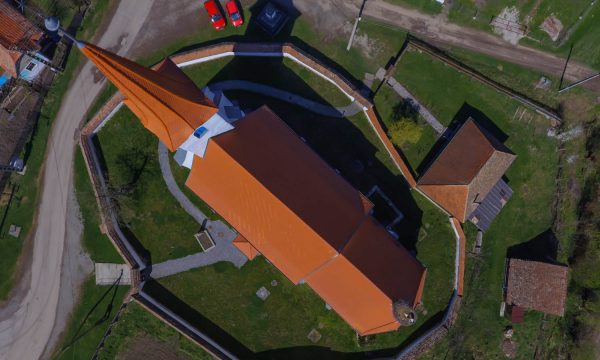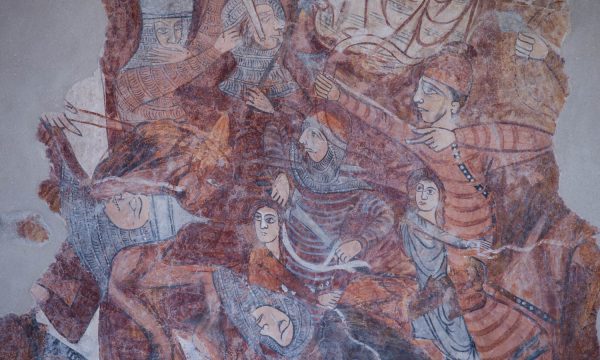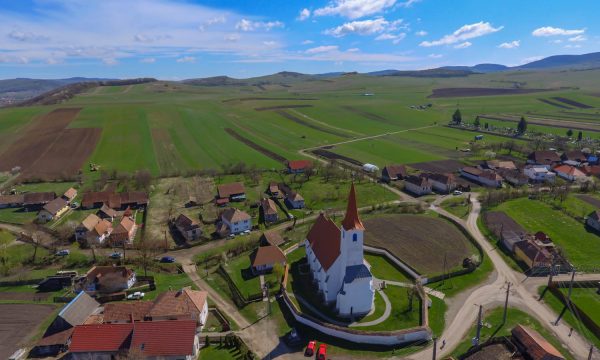Wall Painting
Mugeni hosts one of the most important churches of Udvarhely Seat, with the most mediaeval parts preserved. There are no archival sources for its mediaeval construction history, but during the large-scale interior works carried out in 1965–67, the foundations of the former semicircular apse were found beneath the chancel flooring. Thus, the church was probably built as early as the 13th or 14th centuries.

Its significance is confirmed by the fact that in 1333 it was recorded as having the second highest parsonage income, after Cristuru Secuiesc (Hu: Keresztúr). At the beginning of the 1300’s and in the second half of the century, the nave walls were covered with murals in at least two phases, and we even found traces of paint on the façade. In the second half of the 15th century a major reconstruction took place, when the early chancel was demolished and a new one was built with ribbed vaults leaning on corbels. It is thought that the congregation converted to the Reformed faith already in the middle of the 16th century, and the church’s current furnishing was completed only after that. The destroyed vault of its nave was replaced in 1724 by a painted coffered ceiling, and in 1749, with the material support of György Korda and István Borsa Nagy, the church received tile roofing, and a new flooring. Inside, the walls were largely re-rendered and then painted. This was when its masonry pulpit was built. In 1842, its “tower in old style, with a porch” was raised with one level, and in 1865 the tower, weakened by floods, was reinforced with thick masonry and additional buttresses. It was during this work that a new window was opened on the nave’s northern wall, and the wall paintings were found.

During the 1995 façade renovation, the old rendering was largely removed, thus we were able to find the ornamental frames of the mediaeval murals in fresco technique only on a smaller surface. Moreover, as it turned out, the square stones of the former, demolished chancel were reused in the buttresses of the Gothic chancel, and on some of the elements facing outwards we could observe the remains of drapery and figural details. However, during a complete renovation finished over the past years, Lóránd Kiss, Péter Pál, and their colleagues have discovered a larger composition on the nave’s southern wall. Today only the interior western and northern walls of the nave are known to have mediaeval wall paintings. The frescoes were painted in at least two periods. The two upper registers could have been made in the first half of the 14th century, where in the upper part we can see fragments of the Saint Ladislaus legend and below it the legend of Saint Margaret. The cycle depicting the knight king’s battle of Chiraleș (Hu: Kerlés) was unfortunately heavily damaged during the 15th century building of the vaulting, respectively in the 19th century, when a window was opened here, but the two lower registers are relatively intact. The Last Judgement scene of the lowest register is the most intact one, which is also extremely interesting from an iconographic point of view.
This monumental ensemble of wall art was uncovered by József Huszka in 1898, but its professional restoration could only be completed in 2012. During these works, the fragments of the Saint Ladislaus legend became more intelligible. The best preserved scene is found on the western wall, depicting the king riding out to battle, which is special both in its depiction and its location. The battle scene depicted on the northern wall is also of a relatively larger surface. This highly dynamic composition with many characters has many unique features. From the chase scene only a 2 m²

fragment survives today, the same as from the wrestling scene, where both heroes and horses are struggling with each other. The scene of decapitation is also extremely fragmentary. This is the consequence of the late Gothic vault construction and of the 19. century window opening.
Natural Heritage
Bögöz is located on the Târnava Mare (Hu: Nagy-Küküllő) river, in the middle of the river, in the Bögözi cove. The words “bő köz” – “bö gőz”refer to the location of the settlement between the Bonta and Décsfalva gullets. The area is bordered by natural formations and a beautiful landscape at the upper mouth of the Bonta gullet. Within a short walking distance from the train station or from the DC218 road to the east, the Râul Târnava Mare între Odorheiul Secuiesc şi Vânători Natura 2000 nature conservation area (ROSCI0383) provides aquatic habitats for amphibians and fishes that are on the IUCN Red List of Threatened Species. Walking in the village we can observe the yellow-bellied toad (Hu: unka) (Bombina variegata) on the shore of the Great Küküllő, named so because of the yellow belly and the silent “unk-unk” sound of the males. It may seem like an undemanding species, but its conservation is very difficult, because the temporary waters that are its home and breeding space are sensitive to the cultivation of soil and the extreme weather. We can also observe our small-scale fish species, the European bitterling (Rhodeus sericeus amarus).

Male specimens put on a glittering nightgown in the colours of the rainbow during the mating season. The river water is inhabited by the spined loach (Cobitis taenia), which is active during the dark hours. When held in hand, the extensible spikes will give away the origin of its Hungarian name, “vágó csík” (“cutting loach”). The thick shelled river mussel (Unio crassus) likes shallow, clean, sandy river sections. It is important to protect it, because the other species depend on its presence, but the high pollution levels have reduced its population. Walking along the quieter parts of the river at night or during winter we might see a European otter (Lutra lutra). We can observe how it hunts or plays in the water. Unfortunately, due to the fragmentation of its habitats, we rarely encounter it. As the river passes through the village, the nature conservation area is heavily influenced by human activities, which may interfere with these species. For them, maintaining the habitats in the area is vital.
